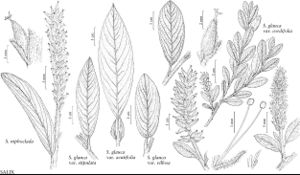Salix glauca var. villosa
Proc. Amer. Acad. Arts 4: 68. 1858.
Plants 0.3–2 m. Stems: branches yellowbrown or redbrown, villous, soon glabrescent; branchlets sparsely to densely villous or tomentose. Leaves: stipules sometimes marcescent, rudimentary or foliaceous on early ones, foliaceous on late ones, usually inconspicuous, narrowly elliptic to ovate, 0.9–2.8–8 mm, apex acute; petiole 3–14 mm, villous or pilose adaxially; largest medial blade (often amphistomatous), narrowly elliptic, elliptic, oblanceolate, or obovate, 29–80 × 8–24 mm, 2.2–3.9 times as long as wide, base sometimes rounded, apex acuminate, acute, or convex, abaxial surface pilose or moderately densely villous to glabrescent, hairs wavy, adaxial pilose or moderately densely villous to glabrescent; proximal blade margins entire or serrulate; juvenile blade sparsely to densely villous. Catkins: staminate 19–53 × 9–14 mm, flowering branchlet 1.5–20 mm; pistillate slender to stout, 19–56 (–60 in fruit) × 7–18 mm, flowering branchlet 2–27 mm; floral bract tawny, greenish, brown, or bicolor, 1–3.4 mm, apex convex to rounded, hairs wavy. Staminate flowers: abaxial nectary 0.1–0.8 mm, adaxial nectary oblong or ovate, 0.6–1.3 mm, filaments distinct, glabrous, or hairy on proximal 1/2. Pistillate flowers: adaxial nectary sometimes flask-shaped, 0.6–1.4 mm;, stipe 0.3–1.5 mm, ovary pyriform, densely villous or tomentose, beak gradually tapering to or slightly bulged below styles, ovules 6–15 per ovary, styles connate to distinct 1/2 their lengths, 0.4–1.4 mm, stigmas flat, abaxially non-papillate with rounded tip, or slenderly to broadly cylindrical, 0.2–0.4–0.64 mm. Capsules 5–8 mm. 2n = 114.
Phenology: Flowering mid May-late Jul.
Habitat: Riparian in subalpine and boreal forests, forest openings, sedge meadows, treed bogs, talus slopes, boulder fields, snowflush areas, alpine tundra, limestone shale, schist, granite, quartzite substrates
Elevation: 150-3800 m
Distribution

Alta., B.C., Man., N.W.T., Sask., Yukon, Colo., Mont., N.Mex., Oreg., Utah, Wash., Wyo.
Discussion
Variety villosa is often confused with Salix orestera in the western United States. See discussion under 55. S. orestera.
Hybrids:
Variety villosa forms natural hybrids with Salix brachycarpa and S. boothii.
Selected References
None.
Lower Taxa
"-0.64mm" is not declared as a valid unit of measurement for this property."-8mm" is not declared as a valid unit of measurement for this property.
